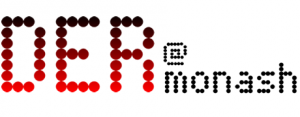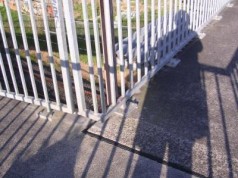Author:
David Elliott (Monash University)
 One of the defining images of the decade will surely be that of marathon runners elatedly running towards the finishing line on a spring afternoon, before a bomb tears through the cheering crowd, and a mushroom of smoke rises out of the chaos. It is an unforgettable image, one which – like the doomed jets of 9/11 erupting into fire – we will see countless times in the coming months and years.
One of the defining images of the decade will surely be that of marathon runners elatedly running towards the finishing line on a spring afternoon, before a bomb tears through the cheering crowd, and a mushroom of smoke rises out of the chaos. It is an unforgettable image, one which – like the doomed jets of 9/11 erupting into fire – we will see countless times in the coming months and years.
As the horrifying events of the Boston massacre began to unfold, we were offered a seemingly endless array of perspectives on the bombing, as images, video, and audio was relentlessly posted to the Internet. From the legless victim being wheeled away from the scene with a desperate, disbelieving look on his face, to a frenzied rescue worker kneeling on a bloody American flag, each image brought with it a new, horrifying piece of the broader narrative of the day.
After the initial shock subsided, social media and online citizen media portals such as Reddit became unofficial hubs of information pertaining to the bombing, as a seemingly endless geyser of information erupted from across the digital world. Photography of the scene, police radio broadcasts, people working at hospitals posting live, annotated Streetview co-ordinates, transcripts of the President’s address, and a thousand other pieces of information, many of which were unauthorized, amateur productions, emerged with a view to keeping the public updated and informed.
The multiplicity of voices, and the collaborative quality of Reddit’s community is illustrative of both the power of online communities during times of crisis, but also of the decreased effectiveness of legacy media such as newspapers and television, which were powerless to match the dexterity, accuracy, and depth of reporting emerging from Reddit’s global community of citizen media participants.
During times of crisis, it becomes increasingly easy to articulate the paradigm shift away from ‘professional journalism’ that this new form of democratised, citizen media has come to represent in the minds of many consumers. Young people in particular, already tech-savvy and positioned culturally as participants in this newly democratised epistemological space, will come to know the Boston massacre through a multiplicity of perspectives, voices, and authors.
Some will certainly be from ‘professional journalists’, and will be found in the traditional architecture of the publishing industry – but many will be amateur participants in citizen media spaces, may be anonymous or under pseudonyms, and will provide fragmentary, transient images, words, and audio. They may be positioned as the authors of their own coverage, collating these images and assembling them in terms of temporality, or narratively, or thematically. They may choose to participate in online conversations and analysis, and – as with the recent Jill Meagher case in Melbourne – may become unofficial ‘detectives’, combing through emergent evidence and anecdote, and attempting to understand the events that are unfolding.
Citizen media and the Australian curriculum
For young people in Australia, the ability to engage in these emergent forms of cultural dialogue while studying in school has been largely removed, through a combination of broader curriculum which fails to meaningfully engage with this new discursive milieu, and through excessive, inflexible filtration of the internet. Indeed, the multiplicity of interactions with emergent content pertaining to the Boston bombing (many of which bring with them vast potential benefits to young people in understanding the events, and often given access to participation in an on-going global dialogue) are largely forbidden in Australian classrooms as they breach many of the mandated uses of school computers and the internet.
This systemic damage to the capacity for students to approach the tragedy in Boston by fulling engaging with the epistemic and technological tools of their cultural moment highlights the broader failing of Australian educational policy to manifest the vision for ’21st Century Learning’ articulated by both the Melbourne Declaration and The Shape of the Australian Curriculum, which articulates a vision for student learning which:
… involves students in learning to make the most of the digital technologies available to them, adapting to new ways of doing things as technologies evolve and limiting the risks to themselves and others in a digital environment. (p. 16)
When responding to the tragedy in Boston, many Australian students will be forbidden to ‘adapt to new ways of doing things’, and certainly cannot ‘make the most of the digital technologies available to them’. The possibilities afforded by this new, democratised citizen media are emblematic of a dramatic, sweeping shift towards ‘a new way of doing things’, which positions students as authors, consumers, participants, collaborators, and analysts. However, this is not supported by the Australian curriculum, and is actively discouraged by the excessive and unthinking ‘blocking and locking’ of school internet resources.
The kinds of digital artefacts that I have described will be difficult to obtain through authorised school computers, unless they are posted to ‘official’ news sites. Students will not be able to participate in the global dialogue, unless it is being conducted from beneath local and departmental filtration, and through the heavily policed and politicised arena of news media websites. They will not be permitted to experience the barrage of ideas and images spewed forth from the global community of the internet, and will instead be forced to receive a version of the ‘truth’ of Boston’s nightmare which has been constructed for them by the machinery of the mainstream publishing industry. The epistemological democracy of the internet will be erased in favour of an easier solution – a gated and sanitised ‘product’, offered by the ‘authorized’, professional media, which can pass unimpeded through an artificially regulated ‘school’ version of the digital world.
Unblocking the Australian curriculum
So what can be done? Clearly, recent events highlight the limitations of currently digital media use in schools – and suggests a rethinking of curriculum and resource restrictions. This might not be as radical a shift as it first seems. For example, the school curriculum in the state of Victoria (AusVELS) stipulates that by year 10, English students will:
… evaluate how text structures can be used in innovative ways by different authors. They explain how the choice of language features, images and vocabulary contributes to the development of individual style. (p. 91)
They will also:
… explain different viewpoints, attitudes, and perspectives through the development of cohesive and logical arguments. (p. 91)
And, they will:
… identify and explore the purposes and effects of different text structures and language features of spoken texts. (ACELY1750)
… understand how language use can have inclusive and exclusive social effects, and can empower or disempower people. (ACELA1564)
In examining the multitude of pedagogical and epistemological opportunities presented by the citizen media response to the events in Boston, I want to present some examples of digital content which is currently not supported by the Australian Curriculum, and whose access is severely limited through an excess of filtration.
Reddit: Reddit’s functionality as a news aggregator and centralised hub of global citizen media allowed for a massive volume of debate, critique, and analysis – as well as a constantly updated list of materials pertaining to the tragedy. In /r/news, the events in Boston became a central focus, and a collaborative dialogue emerged in which a global community of participants shared resources, offered condolences, posted links to both professional and citizen media sites containing new information, and official press materials were transcribed and posted. This valuable and timely resource, which allows students to see an enaction of ‘different viewpoints, attitudes and perspectives’, and which shows text structures being ‘used in innovative ways by different authors’ is currently banned in Australian schools.
Twitter: As one of the most popular social media sites in the world, Twitter is an important tool for many young people, as a way of collaborating, communicating, and engaging in the messy business of 21st century culture. It is, simultaneously, a powerful tool of information distribution, and is used by many sources – both professional and amateur – to disseminate digital content. Having come to school this morning, students were unable to read updates from embedded journalists in the Boston area, they were unable to follow official reports on attempts to deal with emerging threats, they were unable to receive information from the Boston Police Department which would contextualise images and annotated Street views emerging from the area, and they were unable to read eyewitness accounts of events as they are occurring.
Similarly, until they get out of school this afternoon, students are not able to contribute to the conversations occurring through any of these feeds, and they are not able to ask questions, or request clarification from participants in the global conversation. In blocking students from these digital literacy experiences, students are unable to mobilise them in order to meet formal curriculum objectives. They are not able to ‘identify appeals to shared cultural knowledge, values and beliefs’ (ACELA1564), nor are they able to ‘reflect on experiences of when language includes, distances, or marginalises others’ (ACELA1564). They were not able to use these valuable literacy experiences in order to ‘explore models of sustained texts created for persuasive purposes about a challenging or complex issue from other cultures’ (ACELY1756), and instead, their understanding of the events in Boston was a product of the comparatively sluggish and limited architecture of traditional media.
First Hand: One of the more striking possibilities offered by democratised citizen media is the minimising of the distance between audience and event. Multiple layers of journalists, editors, and sub-editors, who act as ‘interpreters’ of events and primary content, can be stripped away – and the voices of direct participants in events are preserved. In many cases, these amateur impressions of events contain a power, intensity, and authenticity which simply cannot be matched by formal journalism:
My friend and I were working over on the corner of St. James and Berkeley St, about one block from the finish after the final food area. We heard and felt two loud pops (think dropping a huge textbook onto a hardwood floor). She thought explosion immediately, I wrote it off as a something falling. A cluster of police near us immediately alerted and started checking their radios. We heard the words two explosions come out of the radios and saw them start sprinting towards the finish line, vaulting barricades on the way. (/u/zadmxm)
While this eyewitness account of the bombing is perfectly positioned to contextualise emergent material pertaining to the central event, it cannot currently be accessed by Australian secondary school students. It cannot be used to analyse the way in which a text ‘positions readers to accept representations of people, events, ideas and information’, nor can it be aligned with ‘multimodal resources, in conjunction with verbal resources, for varying purposes and contexts’ (ACELY1750).
While the first example is a demonstration of the way in which citizen journalism contributes to a deeper and more personal understanding of chronology, it can also provide an emotional density which is unique to this kind of democratised, unregulated media:
I wanted to get closer to help – I know a fair bit of first aid – but they would not allow it. They didn’t need me anyway, they had tons of EMTs and doctors anyway.) The cops needed waters so we ran waters up to the site. Then a cop yells “Get these tables out of the way” – the street had a loooooong center aisle of water tables and Gatorade tables, and the ambulances couldn’t get in. We all started flinging the water out of the way, as quick as we could. There were only like 5 of us volunteers still there though (the rest had been told to leave) and like ten million tables. The crowd is watching us desperately hurling the waters to the side of the street and then the whole crowd starts LEAPING over the security dividers and helping us haul all the waters and tables out of the way… (/u/room317)
This description of the chaotic environment of the bombing is imbued with a gravitas and pathos which is emblematic of the new form of ‘reporting’ enabled by the rise of citizen media. The post containing this description of one participant’s experience is currently banned in Australian secondary schools, despite being perfect fodder for ‘considering ethical positions across more than one culture as represented in text’, and ‘questioning the representation of stereotypes of people, cultures, places, events, and concepts, and expressing views on the appropriateness of these representations’ (ACELY1749).
A question of intent
The Melbourne Declaration stipulates that:
Rapid and continuing advances in information and communication technologies *ICT) are changing the ways people share, use, develop and process information and technology. In this digital age, young people need to be highly skilled in the use of ICT. While schools already employ these technologies in learning, there is a need to increase their effectiveness significantly over the next decade.
In order to increase the effectiveness of ICT use, it becomes necessary to examine the discrepancy that currently exists between the broader claims of the Australian Curriculum, and the technological realities of life in secondary schools. While the Melbourne Declaration acknowledges that people now produce, share, use, and process information through a constantly evolving range of technologies, a large proportion of them are simply not allowed in the Australian public school system.
In examining the potential for rich, complex literacy work to be conducted in response to the tragedy in Boston by engaging with the multiplicity of perspectives, voices, and epistemological opportunities afforded by the escalating rise to prominence of citizen media, it becomes apparent that students are limited in their ability to effectively engage with the complete range of intellectual, cultural, and pedagogical experiences generated during times of crisis.
The kind of innovation and evolution positioned as desirable by the Melbourne Declaration and by the Australian Government is not possible if it is constantly regulated out of existence by misguided policy, ignorance of techno-cultural reality, and a denial of the importance of these new media forms in the lives of young people.




